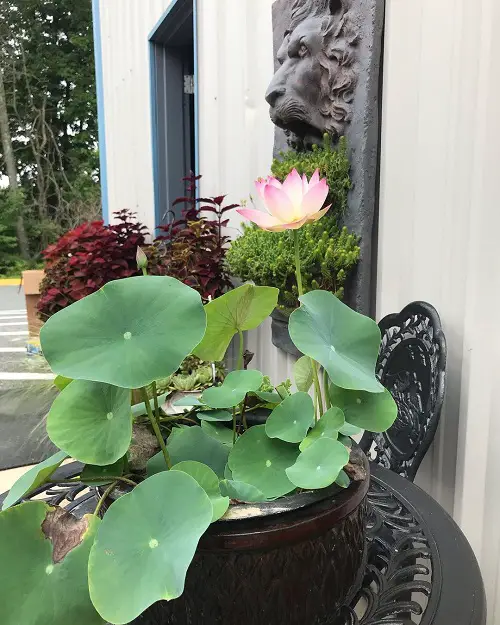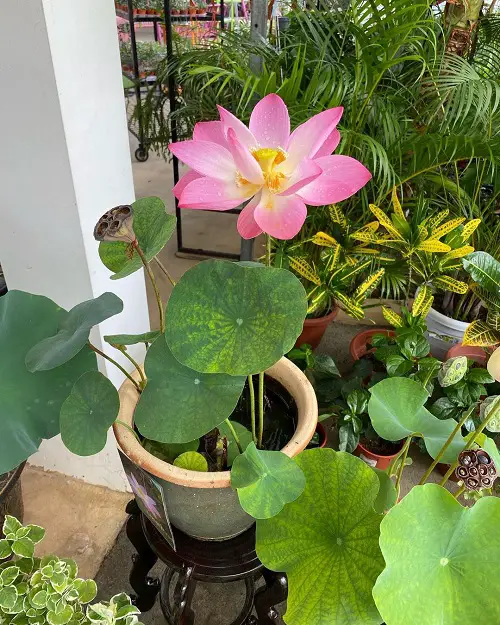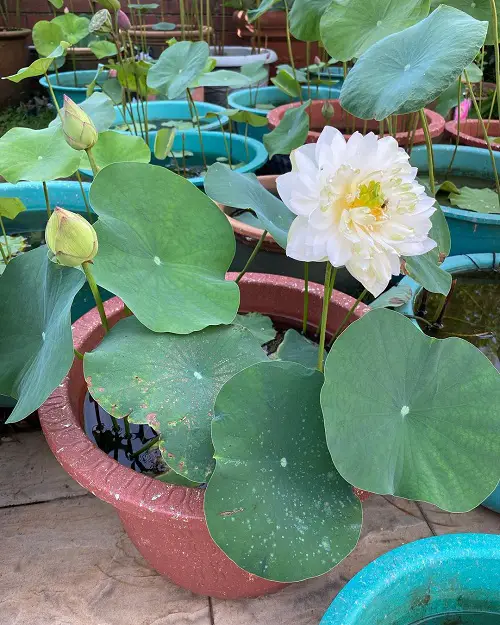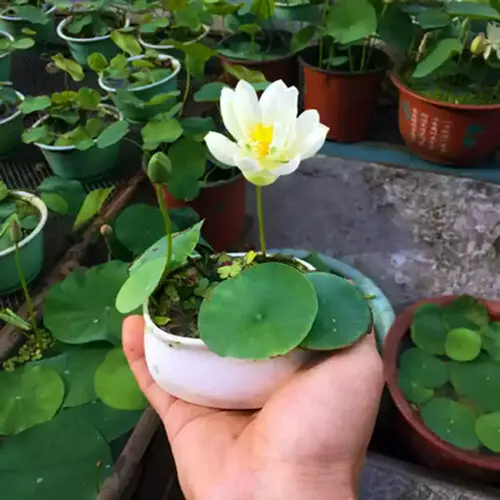Do you want an exotic flower that floats in water? If yes, learn How to Grow Lotus and include it in your home and garden!

Lotus is a jewel of the aquatic world. This exotic flower gets rooted in the soil or mud and emerges above the water’s surface, making it look like it’s floating. Isn’t this amazing? If you too want to experience this, learn How to Grow Lotus in a pot in this post.
Here is a list of the best plants for an indoor water garden
Lotus Plant Information
The Lotus flower is an aquatic perennial plant usually mistaken for Water Lily. The charming blooms can be found in shades of white, pink, or yellow. In contrast, water lily comes in a wide range of colors. The plant can reward its grower with stunning big blooms almost year-round if you live in a warm and tropical climate.
Fact: Lotus is the National Flower of India
Check out the best DIY desktop water garden ideas here
Types of Lotus
The family of Nelumbonaceae includes two kinds of Lotus.
1. Nucifera
Nucifera is native to East Asia, South Asia, and the Indian subcontinent, majorly India and Sri Lanka. It produces white or pink flowers and does best in warm climates. This type only goes partially dormant in winter.
2. Lutea
Lutea is also known as the American Lotus and is native to North America and the Caribbean. It produces yellow flowers and usually grows in lakes, swamps, ponds, or other still water features. This hardy Lotus variety is cyclical and enters a dormant stage in winter.
You can find Lotus plants in different sizes:
- Tiny Exquisite of Bowl Lotus – It is also known as Micro Lotus and grows up to 6-8 inches tall.
- Dwarf or Small Lotus – It can grow up to 1-2 feet in size.
- Medium Lotus – It usually grows up to 2-4 feet.
- Tall Lotus – These are larger lotuses and can reach up to 4-5 feet and is best suited for ponds, lakes, and larger water features with still water.
Can You Grow Lotus in a Container?

The good news is you do not need a big pond or mini-lake to grow Lotus at home. The small tubers can grow in small containers 14-18 inches in diameter. You can also use a whiskey or wine barrel to grow it but make sure you cut them in half to ensure they are not very deep. Here’s a great video you can watch for help.
Fun Fact: Container size is never a restraint when growing lotus, as you can also grow them in a mini pond of your liking, as long as you can do maintainance! So, it can be a container of 15-20 inches or a small pond of 10-60 feet—lotus will be more than happy to thrive.
Here are some of the stunning red aquarium plants
How to Plant Lotus in a Container?
Follow these instructions to plant Lotus in a container:
- Make sure the container you are using has no holes at the bottom.
- Start with 2-3 inches of sand and then top it up with 2-4 inches of soil with clay content. Make sure you use a wide but shallow container to grow lotus, which is the best way to grow it.
- Dig up a small trench using your hand and place the tuber into the hole with the leaves facing up.
- Carefully cover the tuber with a thin layer of soil (not too much). Refrain from compacting it. Be careful not to cause any damage to the runners or tubers while doing all this.
- Add water until the soil is saturated with mud and keep filling until it comes to about 2 inches over the soil.
- Place the bowl or container in a spot that receives full, direct sunlight for at least 6 hours daily.
Look at some beautiful water garden ideas from Instagram here
Propagating Lotus
You can quickly propagate Lotus by dividing a healthy, mature plant. Dividing the lotus plant is also important because it quickly populates the pot by spreading through runners. It could be a smelly and messy task as the plant sits in water, but you should do it before the flowering season starts in summer. Follow these steps:
- Gently remove the plant from the container.
- Using a sharp and clean knife, cut out sections from the tuber. Ensure at least 2-3 “eyes” on each cutting.
- As mentioned in the potting section, take the new cuttings and put them in another container.
- Place the new plant gently in water and avoid any air pockets.
Pro Tip: To save time and effort, it would be a great idea to get a plant from a garden center.
Look at some creative outdoor water fountain ideas here
Growing Requirements for Lotus

Light
Provide at least 5-6 hours of direct sunlight to your Lotus plant daily. Some varieties may only flower if they receive full sun each day.
Do not keep the plant in the shade, as it will result in no flowers.
Soil
Lotus can quickly rot in organically rich soil, and it is perfect to use potting medium made for aquatic plants or clay soil. However, remember not to use potting soil with elements that can float. It should be free from pesticides and herbicides as well. Add only 3-4 inches of soil to the container.
Tip: It is best to use a wider container to allow the rhizome enough space to spread than a deep container.
Pro Tip: You can also buy a potting mix that is especially available for pond plants.
Water
You need to pick a container with no holes and 4 to 10 inches of water above the soil, depending on the variety of Lotus. The smaller kinds can grow in 4-8 inches of water on top of the layer of soil, while taller types need 8-10 inches of water.
Temperature and Humidity
Lotus plants love warm weather and start to grow best in a temperature range of 70-90°F or 21-32°C. The Lotus is not fussy about the humidity and will grow well, with or without it.
Find out the best Japanese garden plants for growing indoors here
Lotus Care

Fertilizer
Fertilize Lotus plants using a good quality slow-release blend. You can also go for bloom-boosting fertilizer tablets. Do this once in 4-8 weeks to promote growth and flowering.
For small varieties, use only one tablet over the entire growing season.
Pests and Diseases
Keep an eye out for any signs of pests, such as yellow curling leaves or spots on the foliage. Lotus plants can be affected by aphids, worms, moths, whiteflies, spider mites, and leaf-eating pests.
Remove any affected parts of the plant and keep the water clean constantly to avoid any fungal diseases.
See the best vegetables and herbs for your water garden here
Overwintering Lotus
If you live in a cold climate, locate the Lotus in a warm place to overwinter it. This can be done by removing the plant from the container. Then, cut it down to 3-6 inches above the rhizome and store it in a clear plastic bag filled with damp sand and peat moss in a place that enjoys a temperature range of 50-60°F or 10-15°C



